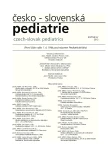Application of ultrasonography in the diagnostics of pyelonephritis
Authors:
Z. Lysá 1; O. Červeňová 1; A. Černianska 1; D. Miklovičová 1; J. Kostolanská 1; J. Lysý 2
Authors‘ workplace:
I. Detská klinika LFUK a DFNsP, Bratislava
prednosta doc. MUDr. O. Červeňová, PhD.
1; Klinika stomatológie a maxilofaciálnej chirurgie LFUK a OÚSA, Bratislava
prednosta doc. MUDr. P. Stanko, CSc.
2
Published in:
Čes-slov Pediat 2012; 67 (4): 229-233.
Category:
Original Papers
Overview
Introduction:
Potential complications of acute pyelonephritis include irreversible changes on the kidneys – renal scars, which may result in secondary hypertension and subsequently to chronic kidney failure. In addition to physical examination of the patient, blood and urinary analysis, ultrasonography of the kidneys contributes to diagnosis.
Objectives:
The authors attempted to verify the possibility to use measurement of the resistance index (RI) during acute phase of pyelonephritis for confirmation of the diagnosis.
Cohort and methods:
53 children were eligible in the group (43 girls, 10 boys) at the age of 0–19 years at the first attack of acute pyelonephritis. The patients were divided into three age groups – children up to 4 years, 4 to 7 years and children older than 7 years and they were compared with a group of 29 children without symptoms of acute infection and normal kidney function. Ultrasonography examination of uropoietic tract oriented to kidney morphology was performed in all patients up to 72 hours from the beginning of hospitalization and RI was measured by beans of Doppler sonography.
Results:
In all the three age categories the authors detected significantly higher values of RO in kidneys affected by inflammation as compared with kidneys of the control group. In the group of children up to 4 years the RI values are 0.67±0.05 against RI 0.63±0.03 of the healthy individuals, in the group of children from 4 to 7 years the RI values were 0.70 (0.69; 0.75) as compared with RI of the healthy group 0.63 (0.61; 0.65) and in the group of children older than 7 years the values were 0.67±0.04 against 0.60±0.03.
Conslusion:
The possibility to use of the resistance index (RI) during acute phase of pyelonephritis contributes to diagnosis.
Key words:
resistance index, Doppler sonography, acute pyelonephritis, kidney disease
Sources
1. Jakobsson B, Nolstedt L, Svensson L, et al. 99mTechnetium-dimercaptosuccinic acid scan in the diagnosis of acute pyelonephritis in children: relation to clinical and radiological findings. Pediat Nephrol 1992; 6 (4): 328–334.
2. Linné T, Fituri O, Escobar-Billing R, et al. Functional parameters and 99m technetium-dimercaptosuccinic acid scan in acute pyelonephritis. Pediat Nephrol 1994; 8 (6): 694–699.
3. Björgvinsson E, Majd M, Eggli KD. Diagnosis of acute pyelonephritis in children: comparison of sonography and 99mTc-DMSA scintigraphy. Am J Roentgenol 1991; 157 (3): 539–543.
4. Terry JD, Rysavy JA, Frick MP. Intrarenal Doppler: characteristics of aging kidneys. J Ultrasound Med 1992; 11 (12): 647–651.
5. Keogan MT, Kliewer MA, Hertzberg BS. Renal resistive indexes: variability in Doppler US measurement in a healthy population. Radiology 1996; 199 (1): 165–169.
6. Bude RO, DiPietro MA, Platt JF, et al. Age dependency of the renal resistive index in healthy children. Radiology 1992; 184 (2): 469–473.
7. Keller MS. Renal Doppler sonography in infants and children. Radiology 1989; 172 (3): 603–604.
8. Wong SN, Lo RNS, Yu ECL. Renal blood flow pattern by non invasive Doppler ultrasound in normal children and acute renal failure patients. J Ultrasound Med 1989; 8 (3): 135–141.
9. Terry JD, Rysavy JA, Frick MP. Intrarenal doppler: characteristic of aging kidneys. J Ultrasound Med 1992; 11 (12): 647–655.
10. Kaiser C, Götzberger M, Landauer N, et al. Age dependency of intrarenal resistance index (RI) in healthy adults and patients with fatty liver disease. Eur J Med Res 2007; 12 (5): 191–195.
11. Murat A, Akarsu S, Ozdemir H, et al. Renal resistive index in healthy children. Eur J Radiol 2005; 53 (1): 67–71.
12. Friedmann DM, Schacht RG. Doppler waveformsin the renal arteries of normal children. J Clin Ultrasound 1991; 19 (7): 387–392.
13. Platt JF, Ellis JH, Rubin JM, et al. Intrarenal arterial Doppler sonography in patients with nonobstructive renal disease: correlation of resistive index with biopsy findings. Am J Roentgenol 1990; 154 (6): 1223–1227.
14. Alaei AAR, Jafari HM, Khademlou M. Comparing the accuracy of Doppler resistance index of the renal artery with DSMA scintigraphy in children with febrile UTI and prediction of VUR and acute pyelonephritis. Journal of Mazandaran University of Medical Sciences 2007–2008; 17 (61): 96–104.
15. Stogianni A, Nikolopoulos P, Oikonomou I. Childhood acute pyelonephritis: comparison of power Doppler sonography and Tc-DMSA scintigraphy. Pediatr Radiol 2007; 37 (7): 685–690.
16. Bykov S, Chervinsky L, Smolkin V, et al. Power Doppler sonography versus Tc-99m DMSA scintigraphy for diagnosing acute pyelonephritis in children: are these two methods comparable? Clin Nucl Med 2003; 28 (3): 198–203.
17. Dell’Atti L, Borea PA, Ughi G, et al. Clinical use of ultrasonography associated with color Doppler in the diagnosis and follow-up of acute pyelonephritis. Arch Ital Urol Androl 2010; 82 (4): 217–220.
Labels
Neonatology Paediatrics General practitioner for children and adolescentsArticle was published in
Czech-Slovak Pediatrics

2012 Issue 4
- What Effect Can Be Expected from Limosilactobacillus reuteri in Mucositis and Peri-Implantitis?
- The Importance of Limosilactobacillus reuteri in Administration to Diabetics with Gingivitis
Most read in this issue
- Does the postnatal detection of renal pelvis dilation a higher risk of urinary tract infection?
- Total anomalous pulmonary venous return – uncommon cause of failure to thrive in infant
- GM1 gangliosidosis associated with multiple mongolian spots
- Application of ultrasonography in the diagnostics of pyelonephritis
